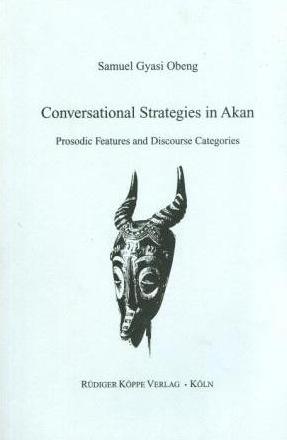


Conversational Strategies in Akan
Prosodic Features and Discourse Categories
Author: Samuel Gyasi Obeng. Series edited by: Wilhelm J.G. Möhlig †.
Series: WK Verbal Art and Documentary Literature in African Languages Volume 7
199916 pp. Roman, 174 pp.
1 map: Akan-speaking area in Ghana, numerous diagrams and tone specimens, author index, subject index
Text language(s): English
Format: 160 x 240 mm
320 g
Paperback
€ 39.80
Buy 'Conversational Strategies in Akan' as a downloadable PDF document directly from our online shop »
Order 'Conversational Strategies in Akan' as print edition »
Besides the exchange of ideas, prosodic aspects like pronunciation and intonation are very important in any conversation. The author chooses Akan, a Kwa language spoken in Ghana, Côte d’Ivoire und Togo by about 8.3 mill. people, to describe existing prosodological phenomena. For example, in the Akan society it is insulting if a younger person speaks louder than an older one. This is the same for persons of lower social status talking to persons of higher status.
Since most linguistic and sociological studies have hitherto neglected the prosodic phenomena, the author’s main concern in his empirical study is the relevance of prosody in natural conversational interaction in Akan. Specifically, he describes how such prosodic resources as tempo, loudness, pitch, pause, and voice quality are employed by interlocutors to manage interactional categories like turn-taking, overlapping talk, repair and other conversational categories.
The author thus explores the link between an aspect of formal linguistics (phonetics) with social science (sociology, ethnomethodological conversational analysis).
Under these links you will find publications by the author, studies of linguistic pragmatics and descriptions of further West African Kwa languages and cultures:
Accompanying material:
- Gesprächsstrategien im Swahili
(ISBN 978-3-927620-41-4 ) - Language and Development
(ISBN 978-3-89645-720-2 ) - Speech Acts and Speech Events in African Languages
(ISBN 978-3-89645-893-3 ) - Topics in West African Discourse-Pragmatics
(ISBN 978-3-89645-856-8 )
Cross-reference:
- An English-Efutu Dictionary
(ISBN 978-3-89645-513-0 ) - Basic Ewe for Foreign Students
(ISBN 978-3-89645-584-0 ) - Bridging the Language Gap
(ISBN 978-3-89645-890-2 ) - Contes et textes documentaires kwa de Côte d’Ivoire
(ISBN 978-3-89645-267-2 ) - Dictionnaire Fon–Français / Français–Fon
(ISBN 978-3-89645-472-0 ) - Le Maxi du Centre-Bénin et du Centre-Togo
(ISBN 978-3-89645-031-9 ) - Les emprunts linguistiques d’origine européenne en Fon (Nouveau Kwa, Gbe: Bénin)
(ISBN 978-3-89645-036-4 ) - Morphophonologie des langues kwa de Côte d’Ivoire
(ISBN 978-3-89645-545-1 ) - Studies in Ghanaian Languages and Linguistics
(ISBN 978-3-89645-366-2 ) - Voices of Affliction
(ISBN 978-3-89645-245-0 )
Reviews
Stanislaw Pilaszewicz in Studies of the Department of African Languages and Cultures, 28/2000, 81-84
The existing literature on conversation analysis (CA) has largely ignored the prosodic features that characterize spontaneous dialog, focusing instead on ‘spoken prose, “invented” discourse, or written text’ (2). In addition, most previous studies of CA deal with English or other major Indo-European languages, with pioneering studies of Thai (Michael Moerman. Talking culture: ethnography and conversation analysis, Philadelphia: University of Pennsylvania, 1988) and Swahili (Reinhard Klein-Ahrendt, Gesprächsstrategien im Swahili. Linguistisch-pragmatische Analysen von Dialogtexten einer Stegreiftheatergruppe, Köln: Rüdiger Köppe Verlag, 1992) standing out as the odd exception. Samuel Obeng’s monograph is therefore doubly welcome since it explores the conversational prosody of Akan (Twi), a register tone language of the Kwa subgroup of Niger-Congo spoken in the southern half of Ghana and adjacent parts of Côte d’Ivoire.
O’s main aim is to investigate the pragmatics of prosody in natural speech interactions between native speakers. O is careful to emphasize that the analytical claims he is making are based on objective, empirical data rather than on his own subjective native-speaker intuitions (2). The book’s database consists of a series of unscripted dialogs, recorded on cassette tape during the previous two decades for various other purposes and only later selected for use in the present study. All of the conversations examined represent the Asante dialect of Akan.
The introduction (1–24) provides a brief overview of the most important previous work in the field of CA and also gives rudimentary sociolinguistic data on Akan. A map of Ghana showing the language’s dialectal distribution appears before the table of contents. Some basic information on the language’s phonological system of tones and vowel harmony might have made another welcome addition since many of the conversational prosodic traits discussed in the body of the book interact with lexical prosodic features [End Page 856] in nontrivial ways. This omission is partly rectified by the fact that the dialogs under analysis, while presented in the Latin-based alphabet used to write Asante, contain additional diacritics showing lexical tonal distinctions.
Individual chapters discuss the prosodic techniques and strategies Akan speakers use to mark turn taking (25–53), turn-competitive overlap (54–76), turn noncompetitive overlap (77–94), repair (95–126), and backchannel sequences (127–50). O is especially concerned with juncture, segment duration, and tempo. He uses a fine-grained system of descriptive terms borrowed in part from musical notation to capture specific distinctions in length of pauses or the speed at which a message is delivered. The full inventory of these prosodic conversational notations and terminology appears in the preface (xiii–xv). For example, tempo gradations range from ‘allegrissimo’ (very fast) to ‘lentissimo’ (very slow) and include ‘accelerando’ (getting faster) and ‘rallentando’ (getting slower). The phonetic and pragmatic nature of Akan verbal gestures analogous to English ‘um’ ‘mhm’, etc., are also described. O provides analysis of how all of these features systematically affect the intended exchange of information.
This study is valuable both for the typological perspective its subject language brings to the study of CA, as well as for its innovative examination of a maximally wide range of prosodic features used in natural conversation—features that have all too often been ignored even in more intensively studied languages.
Edward J. Vajda in Language, 77/4, 856-857
| « back | Print version | [top] |
 Books
Books Audio
Audio Biographies
Biographies Series
Series Festschrifts
Festschrifts Journals
Journals